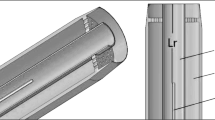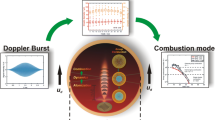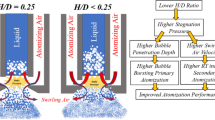Abstract
Increasing concerns about the role of halons on the depletion of ozone in the stratosphere have led to a search for alternate agents for suppression. Water, sprayed in the form of tiny droplets, has emerged as a potential fire suppressant. The present chapter presents a brief review of the recent studies on flame water spray interaction. The effects of water spray on both premixed and non-premixed flames are discussed. The significance of droplet size in flame suppression is explained in details. This understanding will lead to efficient atomizer design for fire suppression systems.
Access this chapter
Tax calculation will be finalised at checkout
Purchases are for personal use only
Similar content being viewed by others
References
G. Grant, J. Brenton, D. Drysdale, Fire suppression by water sprays. Prog. Energy Combust. Sci. 26, 79–130 (2000)
R. Mugele, H.D. Evans, Droplet size distribution in sprays. Ind. Eng. Chem. 43, 1317–1324 (1951)
S.R. Turns, An Introduction to Combustion: Concepts and Applications, 2nd edn. (The McGraw-Hill Companies Inc, USA, 2000)
H. Tsuji, Counterflow diffusion flames. Prog. Energy Combust. Sci. 8, 93–119 (1982)
M.D. Smooke, R.A. Yetter, T.P. Parr, D.M. Hanson-Parr, M.A. Tanoff, M.B. Colket, R.J. Hall, Computational and experimental study of ammonium perchlorate/ethylene counterflow diffusion flames. Proc. Combust. Inst. 28, 2013–2020 (2000)
M.D. Smooke, I.K. Puri, and K. Seshadri, A comparison between numerical calculations and experimental measurements of the structure of a counterflow diffusion flame burning diluted methane in diluted air, in Twenty-First Symposium (International) on Combustion, vol. 21, 1988, pp. 1783–1792
K. Seshadri, C. Trevino, M.D. Smooke, Analysis of the structure and mechanisms of extinction of a counterflow methanol-air diffusion flame. Combust. Flame 76, 111–132 (1989)
G. Dixon-Lewis, T. David, P.H. Gaskell, S. Fukutani, H. Jinno, J.A. Miller, R.J. Kee, M.D. Smooke, N. Peters, E. Effelsberg, J. Warnatz, F. Behrendt, Calculation of the structure and extinction limit of a methane-air counterflow diffusion flame in the forward stagnation region of a porous cylinder, in Twentieth Symposium (International) on Combustion Symposium (International) on Combustion, vol. 20, 1985, pp. 1893–1904
G. Dixon-Lewis, V. Giovangigli, R.J. Kee, J.A. Miller, B. Rogg, M.D. Smooke, G. Stahl, J. Warnatz, Numerical modeling of the structure and properties of tubular strained laminar premixed flames. Am. Inst. Aeronaut. Astronaut. 131, 125–144 (1991)
G. Balakrishnan, M.D. Smooke, F.A. Williams, A numerical investigation of extinction and ignition limits in laminar nonpremixed counterflowing hydrogen-air streams for both elementary and reduced chemistry. Combust. Flame 102, 329–340 (1995)
G. Amantini, J.H. Frank, M.D. Smooke, A. Gomez, Computational and experimental study of steady axisymmetric non-premixed methane counterflow flames. Combust. Theory Model. 11, 47–72 (2007)
G. Amantini, J.H. Frank, M.D. Smooke, A. Gomez, Computational and experimental study of standing methane edge flames in the two-dimensional axisymmetric counterflow geometry. Combust. Flame 147, 133–149 (2006)
N. Peters, Laminar flamelet concepts in turbulent combustion, in Symposium (International) on Combustion, vol. 21, 1988, pp. 1231–1250
N. Peters, Laminar diffusion flamelet models in non-premixed turbulent combustion. Prog. Energy Combust. Sci. 10, 319–339 (1984)
A. Lock, S.K. Aggarwal, I.K. Puri, Effect of fuel type on the extinction of fuel and air stream diluted partially premixed flames. Proc. Combust. Inst. 32, 2583–2590 (2009)
J.S. Park, D.J. Hwang, J. Park, J.S. Kim, S. Kim, S.I. Keel, T.K. Kim, D.S. Noh, Edge flame instability in low-strain-rate counterflow diffusion flames. Combust. Flame 146, 612–619 (2006)
A. Lock, S.K. Aggarwal, I.K. Puri, U. Hegde, Suppression of fuel and air stream diluted methane–air partially premixed flames in normal and microgravity. Fire Saf. J. 43, 24–35 (2008)
A. Lock, A.M. Briones, S.K. Aggarwal, I.K. Puri, U. Hegde, Liftoff and extinction characteristics of fuel- and air-stream-diluted methane–air flames. Combust. Flame 149, 340–352 (2007)
A.J. Lock, A.M. Briones, X. Qin, S.K. Aggarwal, I.K. Puri, U. Hegde, Liftoff characteristics of partially premixed flames under normal and microgravity conditions. Combust. Flame 143, 159–173 (2005)
A.M. Lentati, and H.K. Chelliah, Physical, thermal, and chemical effects of fine-water droplets in extinguishing counterflow diffusion flames, in Symposium (International) on Combustion, vol. 27, 1998, pp. 2839–2846
E.J.P. Zegers, B.A. Williams, R.S. Sheinson, J.W. Fleming, Dynamics and suppression effectiveness of monodisperse water droplets in non-premixed counterflow flames. Proc. Combust. Inst. 28, 2931–2937 (2000)
A.M. Lentati, H.K. Chelliah, Dynamics of water droplets in a counterflow field and their effect on flame extinction. Combust. Flame 115, 158–179 (1998)
H.K. Chelliah, A.K. Lazzarini, P.C. Wanigarathne, G.T. Linteris, Inhibition of premixed and non-premixed flames with fine droplets of water and solutions. Proc. Combust. Inst. 29, 369–376 (2002)
A. Dvorjetski, J.B. Greenberg, Theoretical analysis of polydisperse water spray extinction of opposed flow diffusion flames. Fire Saf. J. 39, 309–326 (2004)
S. Pramanik, A. Mukhopadhyay, Numerical study of counterflow diffusion flame and water spray interaction. J. Therm. Sci Eng. Appl. 8, 011–018 (2014)
M.N. Sasongko, M. Mikami, A. Dvorjetski, Extinction condition of counterflow diffusion flame with polydisperse water sprays. Proc. Combust. Inst. 33, 2555–2562 (2011)
S. Sarkar, A. Mukhopadhyay, S. Sen, Numerical study of the effect of fine polydisperse water spray on laminar flame speed of hydrogen/air premixed flames stabilized in the stagnation flow field, in ILASS-Asia 2016, 18th Annual Conference on Liquid Atomization and Spray Systems—Asia, Chennai, India
A. Yoshida, R. Takasaki, K. Kashiwa, H. Naito, Y. Saso, Extinguishment of counterflow methane/air diffusion flame by polydisperse fine water droplets. Combust. Flame 160, 1357–1363 (2013)
A.K. Lazzarini, R.H. Krauss, H.K. Chelliah, G.T. Linteris, Extinction conditions of non-premixed flames with fine droplets of water and water/NaOH solutions. Proc. Combust. Inst. 28, 2939–2945 (2000)
P.G. Arias, H.G. Im, P. Narayanan, A. Trouvé, A computational study of non-premixed flame extinction by water spray. Proc. Combust. Inst. 33, 2591–2597 (2011)
F. Takahashi, V.R. Katta, Extinguishment of diffusion flames around a cylinder in a coaxial air stream with dilution or water mist. Proc. Combust. Inst. 32, 2615–2623 (2009)
C.C. Ndubizu, R. Ananth, P.A. Tatem, V. Motevalli, On water mist fire suppression mechanisms in a gaseous diffusion flame. Fire Saf. J. 31, 253–276 (1998)
G. Liao, J. Liu, J. Qin, B. Yao, Experimental study on the interaction of fine water spray with liquid pool fires. J. Therm. Sci. 10, 377 (2001)
A. Yoshida, T. Okawa, W. Ebina, H. Naito, Experimental and numerical investigation of flame speed retardation by water mist. Combust. Flame 162, 1772–1777 (2015)
C.K. Law, P. Cho, M. Mizomoto, H. Yoshida, Flame curvature and preferential diffusion in the burning intensity of bunsen flames, in Twenty-First Symposium (International) on Combustion, vol. 21, 1988, pp. 1803–1809
W. Yang, R.J. Kee, The effect of monodispersed water mists on the structure, burning velocity, and extinction behavior of freely propagating, stoichiometric, premixed, methane-air flames. Combust. Flame 130, 322–335 (2002)
A.U. Modak, A. Abbud-Madrid, J.-P. Delplanque, R.J. Kee, The effect of mono-dispersed water mist on the suppression of laminar premixed hydrogen–, methane–, and propane–air flames. Combust. Flame 144, 103–111 (2006)
A. Jones, P.F. Nolan, Discussions on the use of fine water sprays or mists for fire suppression. J. Loss Prev. Process Ind. 8, 17–22 (1995)
J.M. Ingram, A.F. Averill, P.N. Battersby, P.G. Holborn, P.F. Nolan, Suppression of hydrogen–oxygen–nitrogen explosions by fine water mist: Part 1 Burning velocity. Int. J. Hydrog. Energy 37, 19250–19257 (2012)
C. Joseph-Auguste, H. Cheikhravat, N. Djebaïli-Chaumeix, E. Deri, On the use of spray systems: An example of R&D work in hydrogen safety for nuclear applications. Int. J. Hydrog. Energy 34, 5970–5975 (2009)
H. Cheikhravat, J. Goulier, A. Bentaib, N. Meynet, N. Chaumeix, C.E. Paillard, Effects of water sprays on flame propagation in hydrogen/air/steam mixtures. Proc. Combust. Inst. 35, 2715–2722 (2015)
J. Munshi, S. Sarkar, S. Sen, A. Mukhopadhyay, Numerical study of the effect of fine polydisperse water spray on laminar flame speed of hydrogen/air premixed flames stabi-lized in the stagnation flow field, in ILASS-Asia 2016, 18th Annual Conference on Liquid Atomization and Spray Systems—Asia, Chennai, India
Author information
Authors and Affiliations
Corresponding author
Editor information
Editors and Affiliations
Rights and permissions
Copyright information
© 2018 Springer Nature Singapore Pte Ltd.
About this chapter
Cite this chapter
Sarkar, S., Munshi, J., Pramanik, S., Mukhopadhyay, A., Sen, S. (2018). Interaction of Water Spray with Flame. In: Runchal, A., Gupta, A., Kushari, A., De, A., Aggarwal, S. (eds) Energy for Propulsion . Green Energy and Technology. Springer, Singapore. https://doi.org/10.1007/978-981-10-7473-8_7
Download citation
DOI: https://doi.org/10.1007/978-981-10-7473-8_7
Published:
Publisher Name: Springer, Singapore
Print ISBN: 978-981-10-7472-1
Online ISBN: 978-981-10-7473-8
eBook Packages: EnergyEnergy (R0)




